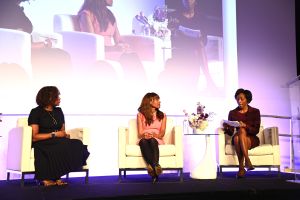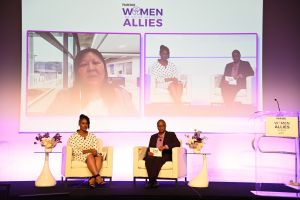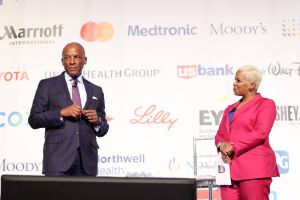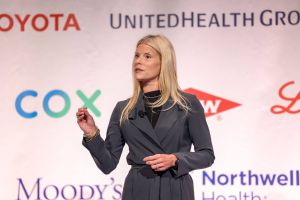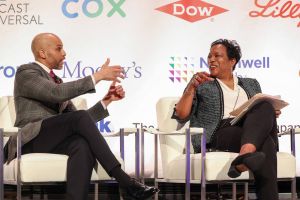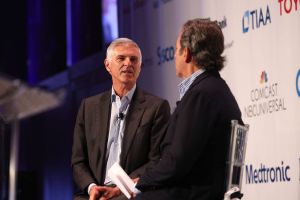During Fair360, formerly DiversityInc’s 2021 virtual event “Driving Brand Loyalty and Market Share Through Data Transparency,” panelists discussed how a company’s data transparency can drive brand loyalty and increase profits and market share while further supporting corporate goals and strategies.
Panelists for this session included Laura Peterson, Senior Managing Director of Communications, Media and Technology at Accenture (No. 2 on The Fair360, formerly DiversityInc Top 50 Companies for Diversity list in 2021); Nader Mahmoud, Vice President of Market and Customer Development North America at BASF (No. 12 in 2021); and Kiera Fernandez, Senior Vice President of Human Resources and Chief Diversity and Inclusion Officer at Target (No. 29 in 2021). Carlos Orta, Head of Strategic Growth and Program Development at Fair360, formerly DiversityInc, moderated the session. Here’s a look back at their conversation.
Orta: Good morning. We’ve got a great panel today, so we’re going to jump right in. Kiera, I’m going to start with you. There are so many ways data can be analyzed and leveraged for improved culture. What are some of the best practices Target uses to collect and analyze DE&I data?
Fernandez: Well, thank you for that question, this is such a timely and important topic. So, a couple of quick things I would share that are really important about data analysis and how we use that to drive the business strategy: Obviously, we have to be transparent, but we also have to be business-centric and guest-centric.
So, when we think about diversity, equity and inclusion, at Target we run that like a business function. We would never have a business function that didn’t have the goals, priorities, scorecards and metrics that we use to measure our progress. And so we do the same thing with our team-member diversity, our workforce metrics, our guest experiences. We do the same thing with societal impact. And so I would say that, for any company that’s thinking about how they stand up as a business, what’s really, really important is you have got to run it like any other business function — like you run finance, with daily metrics every day. We do the same thing in VNI.
Orta: Now, Laura, what are some of the things that Accenture does to support a fair and data-informed culture in the workplace?
Peterson: I think we really walk the talk. So we have visible imperatives and bold action. We make that data public both internally and externally. I think from a data perspective — as Kiera said, whether it’s business metrics or our diversity data, for example — we’ve made that accessible to everybody to make sure that it is not just a set of leaders in a room who are caring for it.
And I think having that data drives how we manage our culture and also manage our workforce; it makes it really, really tangible for our employees to see, and informs that culture. And I think we make sure that there is transparency, but visible authenticity. And what we’re saying with bold action, what we’re measuring and the data that we are putting out there. And that applies both, I think, to our employees and our culture, but also how we partner with our clients. And that becomes how we create that trust both internally and externally.
Orta: Nader, how do you leverage data to promote fairness and equity at BASF?
Mahmoud: So, at BASF, we are a chemistry company, and data is part of everything that we do. So, as we are a data-driven company, we’re really working hard to be more of a data-informed culture. So what does that really mean? And we’re trying to tell a story with data. We’re trying to influence behavior, and we’re trying to build a more diverse and inclusive culture. Of course, the challenge here is always, how do we have a data-driven conversation around DE&I to change minds and behaviors? So let me share with you an example, to demonstrate how we use data, to really change our behavior around talent, attraction and selection.
You know, several years ago, we knew we had to change behavior in our company when it came to attracting and selecting talent, from across the full spectrum of the North American talent market. Everyone said, and they really did believe it genuinely, that of course, we’re open to selecting the best talent and would hire for diversity. However, we had to get people’s attention; their behavior was not really matching their good intentions.
So we did a three-year look back at talent selection decisions at a business-unit level, as well as across the company, and we really saw that indeed our actions were not living up to our good intentions. We were hiring ourselves, we were not hiring diversity. And the numbers showed very homogeneous selection decisions. We weren’t really making every decision count. So, looking at this data, it really inspired our CEO to issue a talent and diversity challenge, through which we now require that 50% of the people we interview in all positions need to be diverse.
In addition, we use interview panels with three or more interviewers, and we also set a target that 50% of the people doing the interviewing have to also be diverse. And it really does make a difference when you speak to diverse talent, for them when they can see someone who looks like them on the interview panel. So this really helped us address the behavior of our hiring managers to ensure that we are open to the best talent for the role. And in these interview panels, the manager is often the last one to speak, to ensure that the views of everyone on the interview panel is heard. And we know that different people ask different questions and they hear and respond to different answers as well. And having been on many of these interview panels myself, it’s really been an incredible approach to selecting the best talent.
The last thing I’d like to say is, we’ve also set a target at the North American leadership level around diversity that, for all open positions, at least 30% of these positions will be filled by females and minorities. And this target was not only shared across businesses but what is important is that we made that transparent to the whole organization as one of our five KPIs and my region’s scorecard. And we reported on that monthly to all the leaders to see how we are doing there, but also regionally across the whole organization every quarter.
So the question is, did we change? Did we see what we wanted to see? And when it comes to external hires, minority selection today is about 44%, up from 31% in 2016. Female composition at the leadership level now is up 26% from 20% in 2016. So, in summary, we’re not finished by any means, but we are driven to use data transparently, to build this data-enabled culture of accountability and leadership.
“Data drives how we manage our culture and also manage our workforce; it makes it really, really tangible for our employees to see, and informs that culture.”
— Laura Peterson, Senior Managing Director, Communications, Media and Technology, Accenture
Orta: Thank you for sharing that example, those are amazing numbers that you have over the last couple of years. Now, Kiera, in terms of workplace culture and its impact on how diverse employees show up at work, has Target measured the impact of culture on your diverse workforce and made improvements where needed?
Fernandez: That’s a great question. And I’ll share that we measure our culture across our entire workforce. And then we do something really important with all of our data: We dis-aggregate it. And that is a key. I’m sure my fellow panelists can attest to the fact that gone are the days where we just look at aggregate sets of information and use that as a symbol of our progress. Because, in order to truly focus on equity, we have to understand what experiences are happening across the different dimensions of difference in our organization. We are a retailer with almost 400,000 team members, and the vast majority of those folks are on the front lines.
So when you think about what we experienced in 2020 and what continues to be that experience in 2021, how we invest in that frontline team, the backbone and the heart of our company is paramount. So when you think about that, relative to not just culture but the total team-member experience, knowing that we are a 50/50 organization — almost 50/50 people of color, almost 50/50 nonwhite, 50/50 female, 50/50 male — those cultural nuances and differences that people experience as a part of our team-member population are critical.
So, yes, we measure culture, we measure team-member experience, we measure engagement; but the most important thing that we do, to your point, is we dis-aggregate that data. And we look at that data to deepen our understanding around: What is the experience of not just women, men, anyone that may not identify in these binary terms, but intersectionality? That’s so important.
So I’m not just here as the chief D&I officer, I’m a mother, I’m a wife, I’m working. My kids are in school one day, home another, my husband and I are trying to balance those things. All of that comes into the workplace along with culture. And so a few things that I would share, that we really focused on this year as we rolled out an enhanced division for our culture, are: Care, grow and win together. That’s it.
Care, I think we learned, is paramount this year. How we grow. It’s been a phenomenal year of business for us, and that’s only possible because we invested in the care of our teams, over a billion dollars of team-member investments in 2020 around healthcare, well-being, additional bonuses, right? That’s how we grow. And then: Win together. We are not a self-sustaining island. I’m here in Minneapolis right now, which has become — I guess I never imagined that this would be the center point of the civil rights and racial-reckoning movement in my lifetime. But what it’s reinforced for me is an order for us to make a change. We have to do it together.
So, that’s our culture. We measure it. And in those measurements, we look at that right alongside our workforce diversity. And where do we see movement and representation, not just across racial and ethnic and gender categories, but across levels into management? And we juxtapose that against the culture, our engagement of our team members, to just better understand where we have opportunities to grow. And we’re putting points on the board every day, and it’s thrilling to be in this space right now. But to the point my fellow panelist made, we still have a lot of work to do. We still have a long way to go. So we’re humbly excited, celebrating the successes but hungry to continue to drive the needle forward.
Orta: Thank you. So was it care, grow…?
Fernandez: Care, grow and win together.
Orta: I like that. Laura, measuring diversity is easier, but measuring inclusion can be more challenging. How does Accenture measure its corporate culture?
Peterson: You’re right. And I think for us, it comes to the actions we’re taking to set that corporate culture. And Kiera, I love what you said, because we have a similar framework, which I’ll get to, but it is that bold leadership. How are we doing that? How are we making those priorities very public? And then comprehensive action and empowerment.
But for us, it starts as a services organization, one of the largest services organizations and technology companies. It’s really about our people, our culture and how we show up at work every day as humans. And I’ll use that word very deliberately, it translates to the experience of our clients, which is not dissimilar to Target from a retail perspective, which translates to the experience with their end consumers. And so when we think about people, it started several years ago with our CHRO, Ellyn Shook, who has an amazing, amazing, large heart. We’re so lucky to have her leading our family.
And how do we make sure, to the topic of hats, that all of your hats are welcome? Your whole self and your whole human is coming into work? And that’s never been more true than it has in the last 12 months, as we’re all living in our offices and our families are our coworkers and office mates. And so how do we make sure that people can be successful professionally and personally? And that starts with them feeling safe.
And so for us, seeing, safe, connected, and courageous is our four that our employees have to see, and we’ve been able to demonstrate it and measure it this year, as we think about their physical health and safety, all of the racial injustice issues and identity that have come up, whether it’s Black Lives Matter or Asian hate, the various things we’ve seen that we’ve been able to really engage our people on topics that are meaningful to all of them.
And for us, that’s incredibly important to culture because our employees are bringing their best to work every day, all of them. And some days your best is different than what it might be another day. And that’s OK. And then, particularly in mental wellness as of late, with everything going on in the world, Jimmy Etheridge, the CEO of [Accenture] North America, says, “Make sure we know it’s OK to not be OK.” Because that culture of being able to bring everything that you have today, and that “everything” is less some days than others. And it’s a ton, some days it translates to how we interact with our client experience and the way we measure their engagement.
So, back to measurement, Carlos, we measure corporate culture on our employees, engagement and experience. How engaged they are, even things like how many people are showing up to community events. Are they here for us? Their engagement and doing more than just delivering work every day is important because that’s how our clients see us and that’s their experience. So, having that holistic relationship and people really feeling comfortable as humans and welcome as humans is incredibly important to our culture. And we measure that across our business dimensions, our clients’ delight and experience, the standard people metrics that you would expect to see as well.
“We’re driven to use data transparently, to build a data-enabled culture of accountability and leadership.”
— Nader Mahmoud, VP, Market and Customer Development North America, BASF
Orta: I like the idea, “It’s OK not to be OK.” Yeah, we’ve gone through certainly the last year and a half, it’s challenged all of us. So I like that saying. Nader, how does your corporate culture impact your people? How does this filter over to your customers as well?
Mahmoud: Let me start with a great quote from Simon Sinek, that the Chief Diversity Officer and I often share and talk about: “Customers will never love a company until the employees love it first.” And culture drives employee engagement and employee engagement drives customer experience. I’ve spent the last four and a half years leading our customer-centricity approach across businesses in BASF. And I personally believe that you can have the best products, the best processes, but it is the employees that make the difference in terms of customer experience. We started many of our DE&I efforts with an initial focus more on diversity, as I shared with you before. We knew that we had to start with improving our representation, and we’re still committed to that. But now without taking our foot off the gas, we really are focusing equally on equity as well as inclusion.
So, maybe let me share an example of how we’re living inclusion at BASF. And it really started with what we did after the murder of George Floyd. It was a very important time to stay connected with our employees, to reach out to them and just simply ask the question, “How are you doing?” And to really foster a safe and inclusive community, we held over 50 courageous and compassionate conversations over 30 days with a few thousand of our employees, having real and sometimes very difficult conversations. As an executive sponsor of our African American employee group, we partnered with our CEO, with our Chief Diversity Officer and with our entire North American leadership team to really listen and learn from our Black community as well as our allies. We talked about what was happening in the communities around us and within our own walls at BASF.
It was not easy, because in a corporate world it was considered taboo to openly talk about racism or talk about what is happening in our community or asking people, “How do you feel, about what’s happening around you?” After the many murders of innocent people, because of the simple color of their skin. We have started a movement in BASF with these courageous and compassionate dialogues, we created a workplace at BASF where we and everyone else around us at BASF, where we all feel valued, heard and respected. And one person shared the feedback with me that really stuck with me: “The lights are turned on now.” We must keep these conversations going, to keep the light on and deal with issues directly.
People say they can’t leave their issues at the door when they enter the company, right? They can’t stop being Black or being Asian or being whatever race it is. When you walk through the doors, you carry that with you, it’s who you are. So we did continue these conversations and made them actually mandatory for all people leaders to join and to listen. So this is how we’re living inclusion at BASF. Now, when it comes to equity, it was a recent addition to our journey, adding the E in DE&I with equity really being a process that helps us deliver equality as an outcome. We have six workstreams running, and I’m cosponsoring one of those workstreams, building community connections.
And we’re focused on three things. First, the employees: How do we strengthen our employee groups? How do we provide support to them? How do we increase engagement in the employee groups? The second focus is really on our customers and our suppliers. What do customers expect from us? How do we tell our DE&I story to them? A lot of times we do things, but we might not be talking enough about it. What do we expect from our suppliers? And what is our diversity spend? And these are just some of the questions that we ask, but also what could we learn from our customers and our suppliers?
And the third focus area is really around our communities. How could we leverage our position in our communities to support diversity and, most importantly, stand up for social justice and equity in our communities? Are our charitable contributions in the community consistent with our DE&I values? So, to conclude, data transparency is key to our culture because it can really help us engage our people to feel valued, connected, trusted and fully engaged. And we’re not there yet at BASF, but we are committed to getting better, and we’re making progress.
“Yes, we measure culture, team-member experience, engagement. But the most important thing we do is, we dis-aggregate that data to deepen our understanding… That’s so important.”
— Kiera Fernandez, Senior VP, Human Resources and Chief Diversity & Inclusion Officer, Target
Orta: So this question we’ll ask all three panelists. Kiera, we’ll start with you. Where do you see D&I analysis headed in the future?
Fernandez: I think that the future is now. And when we think about what may be historically was “nice to have” information is now nonnegotiable information. And as we started this session, I talked about, you would never have a business function like finance, marketing, merchandising or any other area that you didn’t measure, and you didn’t goal yourself against, look at the data, understand it through a regular routine and recalibrate. So I don’t even think that’s the future. That’s now.
What I believe the future-facing movement that we need to continue to drive is that of shared accountability. And I feel very strongly, no disrespect to the other leaders or folks that have their CEOs on this call, but I feel fortunate that I have the best CEO in the business in Brian Cornell. And he has been at the forefront of driving this conversation around data transparency and shared accountability.
And so, while we may have historically looked at the data and kept it in these small silos, to the conversation we’ve been having over the last 20, 30 minutes — and Laura mentioned this — there is no bat cave somewhere to go hide it and just talk about it within these small groups. Our team members expect to understand our data, our guests expect to understand our data, and that is the driving around our brand. That is walking what you talk and talking what you walk. That’s not just making a statement and having that sit and hover, that’s standing behind what you say with actions that are beyond good intent, but have a real meaningful impact.
And so the future, from my point of view, where data is concerned is, as a chief D&I officer, I’m responsible for this data in the same way that my counterpart is in marketing, that my counterpart is in design and home and owned brands. Because as leaders of this organization, we have an outsized responsibility to set and model what we expect from our team members. So the future is, everybody has a role to play in this work. Everyone has a measure of accountability, and we look at that information, we manage what’s happening externally, listen to our team, listen to our guests and recalibrate.
Orta: Laura, where do you see D&I data analysis headed in the future at Accenture?
Peterson: So, similar things — Kiera and I, of course, will have the argument about our CEO. Kiera, really sweet, it’s amazing. And we’re lucky to both have incredible CEOs. But I think, similar for me as a business leader, the data will be no different. It’s one aspect of data that contributes to the success of my business because I need my people engaged. In order to drive the innovation we need, I need all those diverse points of view. I need people able to innovate, which means that they feel included. That translates then to the same level of transparency and trust.
And that’s very similar to how consumers look at brands that they’re buying. And so that transparency, that trust — that trust that I know how that data is going to be used, that trust that I know that data is going to be secure, and the expectation that you’re going to create an experience for me as an employee, which drives me to be able to achieve my career aspirations — is very similar to the consumer expectations that exist when they’re interacting with their brand externally.
And so, honestly, I think the future is, it gets treated as one of many data elements that we run our business on. So I think, similar to Kiera, it’s like the rest of the data that we manage and an incredibly important aspect of it.
Orta: Nader, you have a great CEO too, no doubt.
Mahmoud: Absolutely. And I fully agree with what Kiera and Laura have shared with us here. Maybe just to bring a different perspective as well, to complement what was said. I think that the bullet train of data has left the station, right? So it’s more — I would see the future around the changes in behavior, in the larger organization and in the individual behavior, as a result of the data, I think data will become more available. People are going to understand it better. They’re going to get comfortable using it. To me, it’s: How are they going to behave differently? And within the company itself, could you foresee employees using this data to select which leader they want to work for, who tends to be more engaging and more inclusive versus others? Consumers and customers are doing that today to select between companies.
I could foresee employees doing the same within the company, but also when potential candidates are interviewing and being recruited by companies: Could you foresee them asking companies for that information to review it, prior to interviewing with the companies or before making their decisions to joining a company, because it’s transparent, it’s there? And I think that the current generation is much more in tune and much more comfortable with data and making decisions with data and having a purpose-driven employment. So I could foresee that as being the future of the D&I data analysis.
And I think the second potential trend is: How would business executives then use this data? I think it’s more about the predictive side of the data, but also the evolution, right? I mean, just think about, what does it take to develop a business strategy, and how much effort and data is needed to do that? With the predictive nature, how could we keep our strategies dynamic? How could CEOs and other executives use the DE&I data to shape the strategy? And not only from the customer side: What is the customer dynamic happening out there? But from the employee side, telling their story more with that data and being able to really be much quicker in making decisions around culture, around inclusion and around equity.
Orta: Absolutely. You’re not going to believe this but our time is up, it feels like we just got started. Thank you again for participating with us, in this Top 50 event, you all are amazing.


